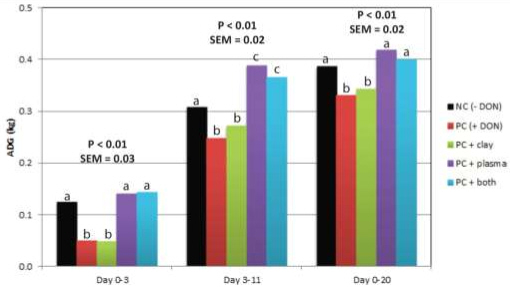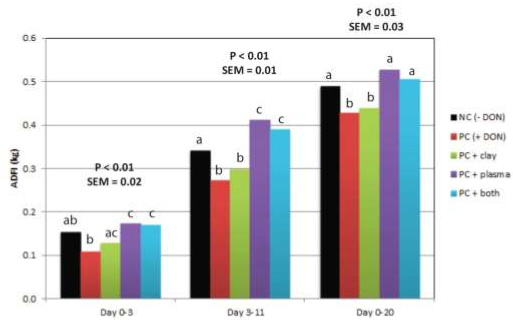



Spray-Dried Animal Plasma Mitigates the Negative Impact of Deoxynivalenol (DON) in Nursery Pigs
Spray-dried animal plasma alleviated the negative effects of deoxynivalenol contamination of the diet for nursery pigs, Prairie Swine Centre researchers told delegates at the 2014 Centralia Swine Research Update.
Deoxynivalenol (DON) is a mycotoxin of concern to grain and livestock producers in Canada. It is prevalent in cool, temperate regions and often occurs on wheat and barley.
The use of DON-contaminated grain in livestock feed leads to depressed feed intake and growth performance. Pigs are especially susceptible to its negative effects relative to other livestock species, and thus a study was carried out to determine if the negative effects observed with feeding DON-contaminated diets could be mitigated by feeding a clay binder and/or spray-dried animal plasma (SDAP).
Pigs fed a DON-contaminated diet plus SDAP performed as well as those consuming a non-contaminated diet in terms of average daily feed intake and average daily gain.
Introduction
The presence of DON contamination in grain is directly related to the presence of head or ear blight produced by Fusarium fungi, which in turn is directly related to the moisture content at flowering and/ or harvest. Possibly due to recent high stress growing seasons, there has been an increase in the presence of DON-contaminated grains in the Prairie Provinces, and it is expected that DON contamination will continue to spread.
Grains contaminated with DON are often downgraded, and either fed to livestock or destroyed. The best strategy for dealing with contaminated grains is to reduce the final concentration of the mycotoxin by dilution; however, this may not be possible if large quantities of contaminated grain are available.
Feeding DON-contaminated diets to pigs has negative effects on performance, and can also affect intestinal integrity.
Contrary to this, including SDAP into swine rations leads to improved performance and has positive benefits on gut health and integrity. This led to the hypothesis that feeding SDAP to pigs consuming DON-contaminated diets would mitigate the negative effects on performance.
The use of activated clay binders is another strategy designed to help reduce the negative effects of certain mycotoxins in livestock, and thus we also hypothesised that adding an activated clay to the diet would improve animal performance in DON-fed pigs.
Materials and Methods
Two blocks of 100 nursery pigs each were used for this trial. Pigs were housed in groups of five per pen with a total of eight pens per dietary treatment. Pigs began consumption of experimental diets three days post-weaning and remained on trial for 20 days.
Bodyweights and feed intakes of the pigs were measured on days 0, 3, 11 and 20. Intestinal samples were collected from the jejunum and ileum for eight pigs per diet at the end of the trial for histological analysis.
Diets consisted of a negative control (NC; 0 ppm DON), a positive control (PC; 3.9ppm DON) and three treatment diets which consisted of the PC diet plus clay (PC+clay), SDAP (PC+plasma) or both (PC+both). Diet formulations are shown in Table 1.

Results and Discussion
Throughout the course of the experiment, the researchers observed no evidence of animals being ill (no vomiting or diarrhoea). Overall, relative to the negative control (NC; no DON), average daily gain and average daily feed intake of pigs fed the positive control (with DON) were reduced by 60 and 100g per day, respectively (P<0.01).
There was no obvious benefit of supplementing the diets with the clay binder, as average daily gain of pigs consuming the PC+clay diet was similar to those consuming the PC diet (P>0.05). Feed intake, however, of pigs fed the PC+clay was numerically improved relative to the PC but was less than the NC (PC+clay 450g per day; PC 400g per day; NC 500g per day).
When SDAP was added to the DON-contaminated diet (PC+plasma), average daily gain of pigs was similar to the NC pigs (420g versus 390g per day; P>0.05).
The average daily feed intake however, was greater for pigs consuming PC+plasma than the NC pigs (550g versus 500g per day; P<0.01).
Performance of pigs fed the PC+both diet was also similar to the NC and PC+plasma fed pigs.
Overall, gain:feed averaged 0.79 and was unaffected by DON, SDAP or the activated clay (P>0.05).
The effects of dietary treatment on average daily gain and average daily feed intake are shown in Figures 1 and 2.

In the intestine, mucosal thickness and villus height were unaffected by dietary treatment. Pigs fed a DON-contaminated diet plus SDAP (PC+plasma) had reduced crypt depth (P=0.04) and thus the villus height to crypt depth ratio tended to be higher.

Conclusion
Inclusion of SDAP improved average daily feed intake and average daily gain relative to the positive DON control, and pigs consuming SDAP with DON performed as well as the negative controls. SDAP alleviated the negative effects of DON. In this experiment, SDAP was more effective than the activated clay.
SDAP should be included into nursery diets if DON-contaminated feed is suspected or known.
Acknowledgement: Strategic programme funding was provided by Sask Pork, Alberta Pork, Manitoba Pork Council, Ontario Pork and Saskatchewan Agriculture and Food Development Fund. Specific funding for this project was provided by Saskatchewan Agriculture and Food Development Fund.
Reference
Eastwood L., J.N. Shea., D.A. Gillis, L. Johnston and A.D. Beaulieu. 2014. Spray-dried animal plasma mitigates the negative impact of deoxynivalenol (DON) in nursery pigs. Proceedings of 33rd Centralia Swine Research Update. II-54–II-56.
August 2014








